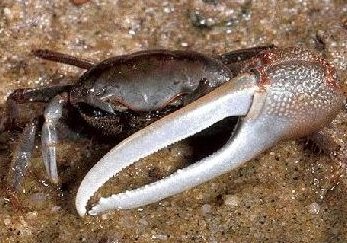Look around at most crablike monsters. There will be a good chance that one claw is larger than the other. As in, possibly bigger than the crab's entire body. Since these are monsters we are talking about, they may even come with electric spikes or blades in between the two parts of the claw.
 |
| This is a particularly worrisome one. |
Surely such a disproportionate crab can't be real. Just imagine a crab like that. It would lose balance all the time...right?

The hundreds of fiddler crabs (genus Uca) exist to prove you wrong. No matter how off-balance they may look, the male fiddler crabs do not tip over on a regular basis thanks to their massive claws. The smaller claw is used almost solely for bringing food (algae and bits of dead flesh) into the crab's mouth. The group is successful enough to inhabit the marshes, beaches, and mangrove swamps of the East Pacific, West Atlantic and Indo-Pacific.
Male fiddler crabs are all endowed with giant claws on one side or the other. They are so named because the smaller of the two claws sometimes looks like it is 'fiddling' the larger claw. Really, the smaller claw is just used for eating, making the fiddler crab one of the few animals that can eat and fight at the same time.
Besides engaging in combat with those massive claws, fiddler crabs are one of the few crustaceans out there with a sophisticated communication system. The crabs will often wave to each other with their large claws. Variations are made depending on visual distance. This is particularly true of courtship displays, which sacrifice feeding time and must be seen as soon as possible. This form of communication is almost like crab semaphore when studied closely. Maybe those PETA folk were onto something; that's pretty smart for a crustacean!
Mind, this doesn't mean that other crabs are ill-suited as monsters. I'm stunned that a certain other crab lacks more monsters, to be honest. More on that when the Week of the Abyss starts up, just in time for Halloween!



No comments:
Post a Comment